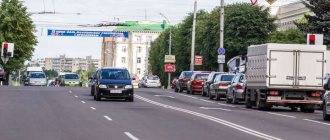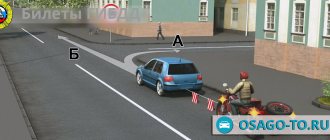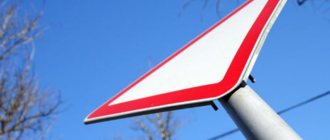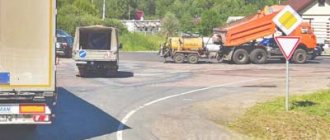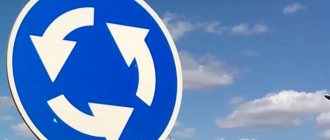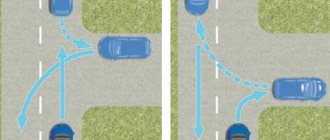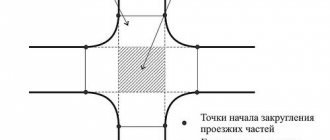Signs
Road signs will help a person driving a vehicle understand which intersection of roadways is in front of him and what the right thing to do is. So, at an unregulated intersection the following signs are set: “Give way”, “Main road”, “Motorway”, “End of the highway”, “Intersection with a secondary road”, “Junction of a secondary road” and others.
You can drive correctly and without traffic accidents only if you know how to read the signs.
Driving through unregulated intersections: rules
Before you start driving at an uncontrolled intersection, be sure to study all the installed signs. And then, taking them into account, begin to move, taking into account the rules. An unregulated intersection will not cause you any difficulties if you know how to read signs and remember traffic rules.
Trackless vehicles have no advantage over a tram, regardless of the direction of movement and the status of the roadway on which they are located. Therefore, cars always let them pass, and only after that they begin to move according to the established road signs.
Rules for turning at an uncontrolled intersection: traffic rules
To understand the sequence of making a U-turn at an unregulated road intersection, you need to decide on the type of intersection.
Depending on some factors, intersections are:
- adjustable. If there is a working traffic light or traffic controller, then such an intersection falls under the specified category;
- unregulated (there is no traffic light, it is not working or is in the blinking mode of the same color, there is no traffic controller).
It is in the second case that much attention should be paid to road signs installed along the way to the intersection and directly near it.
The traffic rules in paragraph 8.11 prohibit driving in reverse at road intersections. That is why the trajectory of movement should be calculated in advance depending on the width of the road section and the dimensions of the vehicle.
At an unregulated intersection, it is also important to determine the priority of the road on which the vehicle is located and correctly assess the situation as a whole.
Making a U-turn at an intersection
There are situations in which a U-turn at an intersection is prohibited:
- presence of prohibition road signs;
- the presence of signs allowing movement only in a certain direction;
- presence of road markings according to which you cannot turn around.
When approaching the intersection, the driver must pay close attention to the presence of circumstances that prevent the maneuver.
Before the road intersection there is a sign “Main Road”
As has been mentioned many times, traffic at uncontrolled intersections depends on the signs installed. Therefore, in order to correctly drive through an uncontrolled intersection of roads, you should know who you need to let through and where you have the advantage. There are several options for driving through an uncontrolled intersection.
It all depends on how the main road is located and your location relative to it.
1. If the vehicle is located on the main road and it continues straight, then the algorithm for moving your car is as follows:
- If you want to drive in the straight direction, you must not give way to anyone.
- If you plan to turn right, you also have the right of way. Accordingly, you pass the intersection first.
- Turn left - first of all, you let oncoming cars pass, which, like you, are on the main road. Namely, you must approach the middle of the intersection, wait until they pass, and only then continue moving. If oncoming vehicles turn left, you simultaneously pass on the right sides of the cars.
- If you are going to turn around, then the sequence of actions is the same as when turning left.
2. The main road turns right. Your actions:
- When moving straight, you remember about the obstacle on the right. If there is a car there, then let it pass, and then begin to pass the intersection.
- Turning right is the only direction in which you have the right of way. Therefore, you can safely fold without giving in to anyone.
- When turning left, you allow cars on the right to pass either straight ahead or to the left. If your obstacle on the right plans to turn right, then you are allowed to move at the same time, since in this situation you are not impeding its movement.
- U-turn. In this situation, the same rules apply as when turning left.
3. The main road turns left. Your actions:
- If you want to go straight, you have priority, so you pass first.
- When turning right, you have an advantage, so, without yielding to anyone, you perform the maneuver.
- Turning left follows the same algorithm as turning right.
- When turning, you must yield to vehicles moving on the left, according to traffic rules. They, like you, pass through an uncontrolled intersection on the main road, and the advantage over them is formed due to the fact that they are an obstacle for you on the right.
Should you always give way to a tram?
For some reason, a large number of drivers are confident that the presence of a tram at an intersection gives them automatic right of priority. Actually this is not true. To begin with, at controlled road intersections, the driver is required to stop the car when the green arrow in the additional section lights up at the traffic light and let other vehicles pass. In addition, driving through an unregulated intersection of equivalent roads with a left turn is carried out with the passage of vehicles moving straight ahead.
When else does a tram not have an advantage? For example, when leaving a depot, it is the mode of transport with standard priority for any road user. And one cannot help but remember that if rail transport moves along a secondary road, then at the moment of approaching the intersection it also does not have priority. This does not negate the fact that if the road is uneven, then you should always give way to the tram. Finally, when two or more trams pass through an intersection of equivalent roads, the “interference on the right” rule applies relative to them.
There is a “Give Way” sign before the road intersection.
According to the traffic rules, if there is a “Give Way” sign on your road, you first give way to cars moving on the main road, and then to those who are an obstacle to you on the right.
Stop at the road intersection:
- There is a “Give Way” sign in front of you. If you want to turn right, you let your obstacle pass on the right (even if it is making a U-turn), and you also let the car pass on the left due to the fact that it is heading along the main road. However, if he turns right, you are allowed to start moving at the same time as him. When driving straight ahead, cars on the right and left have an advantage in front of you, so you give way to them. When you turn left, you let everyone pass. The same is true when making a turn.
- The main road is on your right. When turning right, oncoming vehicles have priority. Also a trackless vehicle on the right in case of a U-turn. You also skip them if you plan to continue straight and turn left. Before turning, you will have to yield to all cars from three directions.
- The main road is to the left of your vehicle. Before turning right, you must yield to oncoming cars and those on the left, because they are on the main road and, accordingly, have the right of way. By letting cars pass on the main roadway (on the left, from the oncoming direction) and on the right (obstruction on the right), you have the opportunity to cross the unregulated intersection in a straight direction. You also do not have the right of way when turning left.
- It is better not to make a U-turn at such an intersection, but if there is no other option, then the maneuver is allowed to begin only by allowing vehicles from three directions to pass.
Crossroads without signs showing the direction of the main road
Example 1. Entry via secondary route
When approaching the intersection, the driver of a white car sees only sign 2.4 “Give way” without an additional sign. This combination means that the main road is a perpendicular road, and two secondary roads are adjacent to it. At the same time, having entered the circle, the driver finds himself on the main road.
- Red. You need to give way, because the red one is driving on the main one, and the white one is still on the secondary one.
- Orange. Both cars are on the main one, but the orange one is approaching from the right. We need to give in.
- Blue. The blue one is on the secondary road, and the white one is on the main road. The white car has priority.
- Green. Same as for orange. We need to give in.
Example 2. Entrance via the main road
The situation is similar to the previous one, only a white car approaches the intersection along the main road.
- Red. Both vehicles are on the main road, the white one is on the right. White has priority.
- Orange. Orange is on the secondary and white is on the main. White has priority.
- Blue. Both cars are on the main road, however the blue one is on the right. White gives way.
- Green. Same as for orange. White passes first.
Driving on unregulated equivalent roads
In a situation where you have to drive through the intersection of equivalent roads, the main rule that you must follow is the obstacle on the right.
Who to skip depends on where you're going. You are planning:
- Turn right. In this situation, you should not give in to anyone, since the advantage is yours, and accordingly, your car passes first.
- Go straight. If there is a vehicle on your right, then you let it pass and then pass yourself. Sometimes it turns out that cars from four directions at the same time plan to cross an uncontrolled intersection of equivalent roads straight. Traffic regulations do not regulate this situation, so drivers must determine among themselves which of them will start moving first.
- Turn left. In these circumstances, an obstacle on your right is an oncoming car on the right side. Based on this, you start moving only after them.
- Make a U-turn. To start this maneuver, you must let the vehicle pass from three directions, and only after that start moving.
U-turn at an uncontrolled intersection
One of the special cases of making a U-turn is its implementation at an uncontrolled intersection. For the correct execution of the plan, it is necessary to control the situation in all directions of movement. In addition, the sequence of driver actions will depend on the type of intersection and its location.
Turning area
A U-turn in an unregulated area is considered more dangerous than in a regulated area. This is due to the fact that in the second case, a turn is carried out only at a green traffic light, and there is no perpendicular movement, since the red light is on. In the case of an unregulated intersection, the driver will have to independently monitor traffic in all directions and take into account other circumstances.
Equivalent roads
A turnaround option is a maneuver at the intersection of roads that are equivalent in terms of traffic regulations. This means the presence of signs:
- absence of “Main Road” and “Give Way” signs;
- identical road surface.
In such a situation, the driver does not have to rely on priority signs. That is why, when making a turn, you should take into account the situation along the entire intersection.
U-turn at a signalized intersection
In addition, you can perform the maneuver using several methods:
- along a short trajectory;
- on the far side.
The first option involves a U-turn with minimal travel to the center of the intersection, and the second is the opposite.
In the second case, the car drives further than the middle of the intersection and only then turns around.
In any case, you cannot travel much further than the center of the intersection, so as not to “touch” the solid line demarcating the flow of traffic. In this case, the driver faces punishment.
At an uncontrolled intersection of equivalent roads, the rule “interference on the right” must be applied. According to it, priority is considered to be the road that is located to the right of the driver and vehicles moving along it must be allowed to pass.
U-turn at an unregulated intersection of unequal roads
The second option for an uncontrolled intersection is with unequal roads.
In this case, as the driver approaches the intersection, he should see a “Main Road” or “Give Way” sign.
In addition, you should pay attention to the presence of a stop sign and a stop line.
In the latter case, the motorist must stop completely and continue driving after assessing the situation in all directions.
When heading to the intersection of unequal roads, you should act depending on which of them the vehicle is located on. A driver driving on the main road has priority in maneuvering over those driving on a secondary road. However, you should give way to vehicles coming in the opposite direction.
If a vehicle is traveling on a secondary route, it will have to give way to all vehicles traveling on the priority road. In this case, you should exercise maximum attention and control the situation along the entire section of the road.
Pedestrian and unregulated intersection
Since there is no regulation at the intersection, in situations where a person is blocking the intersection, one must be very careful. After all, in the event of an accident, he will be given a maximum fine, but for you, as a driver, this situation can result in deprivation of your license and even a prison sentence.
A pedestrian at an uncontrolled intersection, moving along a zebra crossing, has an advantage over any vehicle. If a person decides to cross a roadway that does not have a pedestrian crossing, you are not obliged to let him through. But, as practice shows, it is faster and easier to yield to a careless pedestrian.
Tips for beginners
Summarizing the rules that control the passage of uncontrolled intersections, we can highlight three main points that need to be followed:
- Obstacle on the right at the intersection of equivalent roads. It is imperative to keep an eye out for vehicles on your right.
- When the “Give Way” sign is installed, the driver initially pays attention to the one driving on the main road, then to those driving on the right.
- If there is a “Main Road” sign on the road you are traveling on, then you are carefully watching for those who are also heading along the main road and to your right.
What does every driver face every day, regardless of the type of car, driving experience, etc.? With intersections. And if driving through controlled intersections is not a big problem for anyone, then in other situations there may be confusion, confusion, and, as a result, a dangerous situation on the road. You can avoid this - you just need to refresh your memory of the rules for driving through intersections. This article was created for this purpose - to give new knowledge to beginners or help experienced drivers remember them.
According to the new changes, from November 8, 2021, there will be “Waffle” (“Waffle Iron”) markings at intersections, which will determine the boundaries of the intersection. It is designed to regulate the passage of intersections where congestion occurs and will help implement and comply with traffic rules, as well as levy fines for violators. The fine for entering an intersection or crossing roadways with a traffic jam is 1,000 rubles.
What are the signs of an uncontrolled intersection?
it always has a center where the paths intersect;
interruption of road markings occurs directly at the intersection, but its functions are preserved;
lack of traffic lights;
the presence of priority signs, which determine the rules for driving through unregulated intersections.
Equivalent intersections are those where roads have top priority. When passing them, the standard “interference on the right” rule applies. Unequivalent ones differ in that they are formed by main and secondary paths. Moreover, they can have different surfaces, and then priority for passage is given to vehicles moving on asphalt.
Types of intersections
All existing intersections are divided into:
- Controlled intersection – equipped with traffic lights (including those with additional sections). This type also includes intersections where traffic is controlled by a traffic controller.
- An intersection of equivalent roads without regulation - accordingly, vehicle movement here is not controlled by a traffic light and a traffic controller.
- An intersection of unequal roads without regulation - similar to the one above, but the roads are divided into main and secondary, they are both marked with appropriate signs .
According to their “design” they can be divided into the following types:
- T-junction - one road adjoins the left or right of another. Such intersections do not include exits from the adjacent territory of a residential building, industrial enterprise or other facility. Rules for driving through a T-shaped intersection depend on the type of intersection: controlled or unregulated.
- A cross-shaped intersection is the most common type, when one road intersects another, and at the same level.
- A roundabout , where several roads connect to a common "ring". When entering it, the car reduces speed and moves counterclockwise and makes an exit on the road it needs.
- Multiway intersections are intersections that do not belong to the previous types. Typically connect a large number of roads and are high traffic areas where great care should be taken.
The main road goes straight
Above we consider the option of an intersection without signs 8.13. However, this traffic organization confuses drivers, so in practice, signs are usually installed showing the configuration of the intersection.
Example 3. Entry via secondary route
The situation is similar to the first example:
- We give in to red, orange, green.
- We have priority over blue.
Example 4. Entrance via the main road
The situation is similar to the second example:
- We give in to blue.
- We have priority over red, orange, green.
General rules for driving through intersections according to traffic rules
- Always give way to pedestrians and cyclists crossing the road you intend to turn onto . This rule applies whether the intersection is regulated or not. Fines for not allowing a pedestrian to pass are currently 1,500 rubles.
- It is prohibited to enter an intersection if there is a traffic jam in front of it . Violating this rule will result in you not only joining the traffic jam, but also blocking the path of cars moving through the intersection on the left or right. As a result, instead of one traffic jam, there are three, and the risk of an accident or conflict on the road increases sharply.
With circular motion
Routes with roundabouts have a guaranteed advantage when the car has already entered the roadway. That is, when driving on a circle, even the “interference on the right” rule is not observed; in any case, drivers located outside the ring part must give way. However, in the case when we are talking about an unequal roundabout intersection 4.3, you need to focus on the signs that determine the priority of travel. In addition, relatively recently, such signs began to be additionally equipped with plates, which serve as indicators of a specific direction of travel along the main road. It is thanks to them that it becomes clear to drivers which lane is considered a priority.
There are only a few basic rules for driving through roundabouts: firstly, when driving on a secondary road, you should yield to vehicles traveling on the main road; secondly, when crossing paths on the main lane, the car moving on the right side gives way.
Rules for driving through unregulated intersections
Let's consider the basic rules of travel and possible situations for unregulated intersections of all types.
Equivalent intersection and driving rules
The rules for driving through intersections of equivalent roads are governed by the “interference on the right” rule - the driver must always give way to vehicles approaching from the right side of the roadway. This also applies to those cars that will become an “obstacle on the right” when the driver makes a maneuver.
Consider the situation: you are crossing an equivalent cross-shaped intersection straight ahead, without turning. There are two cars on the transverse road - one on the left (let's call it A), one on the right (it will be designated B), both plan to continue moving straight. According to the “interference on the right” rule, you give way to car B since it is on your right. In turn, vehicle A must give way to you in the same way.
The following situation: you are also crossing the intersection straight, and another car moving in the oncoming lane on the opposite side of the intersection intends to turn to your right (left for it). When starting her maneuver, she is obliged to slow down and let you pass, since your car will be an “interference on the right” for her when making a turn. The same rule works for reversals.
Rules for driving roundabouts
From November 8, 2021, new rules for driving around the roundabout come into force; according to the changes, drivers on the roundabout have priority when passing, and entering vehicles must give way.
At roundabouts, if all of its roads are of equal importance (there is no sign to give way) , then vehicles already on the roundabout must give way to those who are just about to enter, since they are still the same “obstacle on the right.”
When sign 2.4 “Give way” is installed in front of the roundabout , all vehicles entering the roundabout road are required to give way to all vehicles moving around the roundabout.
Also, in front of the roundabout, an information sign can be installed indicating the secondary and main roads when driving along the ring, but sign 4.3 “Roundabout” and sign 2.4 “Give way” must be installed, depending on the situation.
Driving through equivalent intersections with tram tracks
Rule 13.11 states that trams have full advantage over other trackless vehicles, regardless of the direction of movement. Here, the car owner does not receive any benefits from the "interference on the right" scheme. In this case, trams are equal in front of each other and when crossing an intersection at the same time they must be guided by the same rules as ordinary cars.
Driving through intersections of unequal roads
There is a main road, and vehicles entering the intersection from it are given priority, regardless of the direction of travel.
The main road does not always have a straight direction; sometimes it makes a turn at an intersection. In such cases, drivers entering the intersection from the main road are equal to each other and, when determining the queue of passage, must be guided by the principle of “interference on the right.”
Cars driving on a secondary road maneuver using the same principle, but taking into account the need to first give way to those driving on the main road.
Driving through intersections of unequal roads
When approaching an uncontrolled intersection, the driver needs to know exactly which road he is moving on - the main or secondary one. Priority signs will help you determine this.
Let's assume that the signs are in place or you, using the presented technique, have determined that you are moving along the main road. The main road goes straight, i.e. does not change its direction. There are no tram tracks at the intersection.
Let us recall the order of determining priority (in the article rules for driving through uncontrolled intersections): priority for those who approached the main road, priority for the tram (if available) and the “interference on the right” rule.
- You are entering the intersection along the main road, therefore, you have priority right of way over vehicles that are approaching the intersection along the secondary road. It does not matter in which direction you leave the intersection. Pass first;
- The advantage of the tram is that there are no tram tracks at the intersection, therefore, this rule can be skipped;
- The “interference on the right” rule does not apply at an unequal intersection. But if you need to turn left at an intersection or turn around, to do this you must fulfill the requirement of paragraph 13.12 of the traffic rules: you are obliged to give way to vehicles that are driving the same way as you on the main road, towards you in the direction straight or to the right.
So, having arrived at an intersection along the main road and if there are no tram tracks on it, then you have a complete advantage in traffic over other vehicles that approach the intersection along a secondary road.
But even in this case, for safety reasons, it is recommended to reduce the speed and switch to a lower gear in order to pass the intersection with “gas reserve” (or power reserve), i.e. in MKM (maximum torque) mode.
When the engine is running with plenty of power, then, if necessary, you will have the opportunity to either suddenly slow down or accelerate sharply. But you need to brake and change gears before entering the intersection, especially if you are going to turn at this intersection.
A few words about the situation when you intend to make a left turn at an uncontrolled intersection. On a left turn, you can often find yourself in circumstances where the driver of a car driving behind, contrary to all the rules, overtakes.
When you are driving on a main road and there is an uncontrolled intersection ahead where you need to turn left, make sure that no one is overtaking you before turning on your left turn signal. You need to make sure of this in advance, and just before the turn itself, it is best to quickly turn your head left and back and look to the left, into the dead (blind) zone.
If the car driving behind has already started to overtake, you cannot interfere with it - it is better to slow down, let it overtake, and then calmly prepare to make the turn. The article Accident when overtaking at an intersection discusses one of the similar traffic situations.
In the photo above, the main road at the intersection changes direction to the right. In this case, if you continue to move through the intersection on the main road, it is mandatory to turn on the right turn indicator! If you intend to leave the main road “straight”, in this case turning on the left turn signal is not necessary, but it is advisable.
More information about this situation can be found in the article Leaving the main road. When turning left at an intersection, turning on the left turn signal is also mandatory.
What should you do if there is a 2.4 “Give Way” sign at the intersection in your direction? This means that you have approached an intersection of unequal roads on a secondary road and, according to the rules for driving through uncontrolled intersections, further actions will be as follows:
- The vehicles that arrived on the main road pass the intersection first, therefore you stop and let everyone pass (give way to them) who is driving on the main road;
- The advantage of the tram is that there are no tram tracks at the intersection, therefore, this rule is excluded;
- The “interference on the right” rule does not apply at an unequal intersection. But if you need to turn left at an intersection or turn around, to do this you must fulfill the requirement of paragraph 13.12 of the traffic rules: you are obliged to give way to vehicles that are driving the same way as you on a secondary road, towards you in the direction straight or to the right. Turning around at an intersection in such a situation is a very undesirable maneuver. To perform it, it is better to look for another place.
The picture below shows an unregulated T-intersection. Please note that this is the case when priority signs are hidden by the foliage of trees and cannot be seen immediately.
There is another important, one might say, technical point. It concerns the safety of crossing intersections. This is an exit to an intersection and a turn from a secondary road. You can read about it in the article When going to the main road, be careful.
If instead of sign 2.4 “Give way” there is a sign 2.5 “Driving without stopping is prohibited” on your way, then this also means that you approached the intersection on a secondary road, but in this case the traffic rules oblige you to stop, i.e. Stop driving completely before proceeding through the intersection.
Sign 2.5 is usually installed at closed intersections that are poorly visible. Therefore, it is advisable to stop (the sign requires this) and assess the road situation. And only after you make sure that nothing threatens the passage, you can continue driving.
At uncontrolled intersections where there is a pedestrian crossing marked with signs 5.19.1 and 5.19.2, you are required to give way to pedestrians crossing the road not only when you turn right or left (clause 13.1 of the traffic rules), but also when you move straight without changing the direction of your movement ( clause 14.1 of the traffic rules).
The requirement to yield to pedestrians applies to absolutely all uncontrolled intersections where there is a pedestrian crossing, and it does not matter which road you are moving on - the main or secondary one.
If the pedestrian crossing at the intersection is not marked, pedestrians are allowed to cross the roadway along the boundaries of the intersection of roadways, but in this case only after making sure that there is no approaching traffic.
It is not uncommon to come across an intersection where the main road changes direction. This is indicated by sign 8.13 “Direction of the main road”, installed together with signs 2.1 “Main road” and 2.4 “Give way”.
In this case, you need to immediately find out which road you are approaching the intersection on. The algorithm for driving through an uncontrolled intersection does not change, but those drivers who approach on a secondary road need to be especially careful.
Some drivers driving on the main road do not always turn on the turn signal, although they are required to do so. Therefore, until a car with the turn signals turned off enters the intersection, it is impossible to determine the direction of its further movement. The way out in such a situation is to stand and wait until clarity appears, and with it the opportunity to safely pass the intersection.
A special case is when the main road at an uncontrolled intersection turns right, and you need to drive in the forward direction. In this situation, all attention to the right - to where the main road turns, because when moving straight, you will need to give way to cars driving on the right along the main road (paragraph 13.10 of the traffic rules).
In the photo you see below, the traffic lights are turned off, which means that the intersection is uncontrolled, and the main road at this intersection changes direction to the right.
In the article If the traffic light at an intersection does not work, this particular traffic situation is considered and the mistakes of the participants in the accident are analyzed.
Rules for driving at controlled intersections
The rules for driving through intersections with traffic lights are regulated by the traffic lights (which are the main ones) and the signals of additional sections.
Vehicles moving on the main green traffic light must determine priority among themselves in accordance with the “interference on the right” rule. Let's say you're turning left at a crossroads, and an oncoming car is moving straight ahead. When the green light turns on, you must enter the intersection, starting the maneuver, and let the oncoming car pass, and only then complete the turn.
If the red or yellow signals and the additional section of the traffic light are on at the same time, first let through all vehicles for which the main green signal is on, and only then move in the direction indicated by the signal of the additional section.
Video lesson: driving through intersections according to the rules.
An intersection is a point where two or more roads join together. Intersections are a particularly dangerous part of the road due to the fact that vehicle paths can intersect, which will automatically lead to an accident. According to statistics, accidents at intersections, uncontrolled intersections and highway exits are the second most common type of traffic accidents that occur immediately after hitting a stationary object. There are many different types of intersections, which are classified by the number of paths connecting at the intersection and their location. A regular 4-way intersection is the most common type. There are also more complex ones, such as Y-shaped and roundabouts. Access may be controlled by traffic lights, road signs, or "pass-through" rules.
Procedure for making a U-turn at intersections
The situation when a U-turn is performed at intersections deserves special attention; there may be several main points.
U-turn at an intersection with a traffic light
This is the most common situation. It is the safest for absolutely all road users. First of all, you should make sure that there are no signs nearby prohibiting this maneuver.
Only in this case can you make a U-turn. Now all that remains is to wait for the appropriate traffic light signal, let oncoming traffic pass and make a U-turn.
How to turn around at a T-junction?
This is the most difficult situation. Only an experienced driver can handle it. To perform the maneuver, you must drive to the border of the intersection and stop the vehicle. If there are no obstacles on the road, then you can overcome the line of intersection of the roadway and make a U-turn.
It is worth noting that drivers of almost any car can take such a step.
The exception is the vehicle for which the trajectory in a certain area will not be sufficient. This is a rather dangerous process, so it is recommended to choose an easier area for the turn.
Rules for turning around at a signalized intersection
The only difference is that you will need to let the flow of cars pass if they follow transverse traffic. Major traffic participants will be automatically stopped by control equipment. If there are no obstacles, then you can make a U-turn in a similar way.
We should also talk about the road sign that prohibits turning to the left; it in no way applies to U-turns; you can safely perform this maneuver.
U-turn using adjacent territory
This is another rather complex and extremely responsible manipulation. It is worth noting that the adjacent territory means a certain section of the road located near the highway. The first thing to do is drive it.
If it is on the right side, then you will need to use reverse, respectively, if on the left side, then forward. Next, you need to turn on the appropriate turn signal (left or right), let vehicles moving along the main road pass, only after which can you make a U-turn.
When performing this maneuver at an intersection, it is very important to correctly assess the situation on the road; only in this case can accidents and unwanted fines be avoided.
Uncontrolled intersections
Uncontrolled intersections are typically used in locations where low traffic volumes do not warrant the installation of additional traffic control devices or where such traffic control devices may operate ineffectively and cause driver confusion. When passing through such a section, you must follow the rules for driving through uncontrolled intersections and exercise caution. The two most recognizable types of uncontrolled intersections are highway interchanges and roundabouts.
Transport interchange
An interchange is the intersection of two highways at different levels with connecting paths that transfer traffic from one highway to another. The main advantage of an interchange over a conventional controlled intersection is that traffic can enter or exit any highway without stopping or interfering with other vehicles already traveling on the highway. This reduces traffic jams and allows more vehicles to pass through the intersection.
Ring
A roundabout is another type of uncontrolled intersection where traffic occurs around an “island” in the middle. Vehicles located near the roundabout must yield to traffic that is already at the roundabout. Always pay attention to pedestrians and cyclists. Some roundabouts are controlled by priority signs and additional pavement markings, but this does not change the rules.
Road signs
Road signs can be installed directly at the intersection or on the approaches to it. Warning signs are usually installed on approaches, while mandatory signs are installed directly on it. Warning signs such as "Intersection", "Side Road", "T-Intersection", "Y-Intersection" or "Roundabout" indicate when there is an intersection ahead and provide information on how to stripes connect to each other. Other warning signs, such as Road Narrowing, are posted before junctions and alert you to merging traffic so you can change lanes early and exercise extra caution. Priority signs such as “Give way”, “Stop”, and various lane control signs are installed immediately before the intersection. Priority signs at unsignalized intersections on unequal roads advise you on the direction of travel and turn restrictions. Lane control signs are usually placed directly above traffic lanes.
Setting priority signs
Please note that priority signs are installed only before entering the intersection. It is very important. When entering an intersection, the driver must remember its configuration shown on plate 8.13 and subsequently act on its basis:
On the sign above:
- We arrive along a secondary road.
- The first and second congresses will be the main ones.
- The third congress will be secondary.
Unfortunately, in practice you can encounter complex roundabouts where it is difficult for the driver to understand and remember the configuration. For example:
Signs of a similar configuration can be found in the parking lots of large shopping centers. The problem is that there are two parallel secondary roads painted at the bottom of the sign. At the same time, the driver cannot clearly understand whether he is entering the roundabout on the left or right road. It is especially difficult to do this at night, when the boundaries of the intersection are not visible.
Naturally, there are no problems when entering the circle, because both roads are secondary. Difficulties arise when moving in a circle, because... It is not clear which exit will be the main road (first or second).
Fortunately, such non-standard circles are quite rare.
Right of way at intersections
At uncontrolled intersections, the driver must yield to all vehicles that have already entered it. If two vehicles arrive at the intersection at the same time, the driver on the left must yield to the driver on the right. If you are not making a protected left turn under a traffic light with a green arrow, you must yield to oncoming traffic and pedestrians crossing an uncontrolled intersection on the main road. If there is a priority sign before the intersection, you must slow down and yield to all vehicles that are on the protected route. When a stop sign is posted at an intersection, you must stop completely and allow all vehicles to pass. At an intersection where there are stop signs everywhere, the vehicle that exits first has the right of way and enters first. If two vehicles arrive at the intersection at the same time, the driver on the left must yield to the driver on the right. When you enter a street from an alley, driveway, or when you are at a T-intersection, you must yield to all oncoming vehicles and pedestrians crossing the intersection on the main road.
You must yield to all service vehicles (firefighters, police, ambulances) when they display flashing red or blue lights and sound their sirens, even at similar uncontrolled intersections. You must pull over and stop. Do not pass until the emergency vehicle has passed. If you have already started moving, leave the intersection before stopping. An unregulated intersection is one of the most common types. This is a road intersection where there are no traffic lights or road signs indicating the direction. This type is very common in rural and residential areas. As a rule, the passing lane is determined by the order of arrival and the relative position of the vehicles. While you don't need to come to a complete stop in most cases, you should slow down and watch for cross traffic before passing or passing at an uncontrolled intersection. Entering from the right does not automatically give you the right of way and does not exempt you from slowing down before entering the intersection.
Right of way at unregulated intersections
If there are no road signs or traffic signs to help you identify lanes, use caution and use these simple rules to determine who has the right of way at a unequal road intersection.
- The vehicle that arrives first has the right of way.
- If two vehicles arrive at approximately the same time, the driver of the vehicle on the left must yield to the driver of the vehicle on the right.
- When making a left turn, yield to all oncoming traffic.
How to behave at an uncontrolled intersection:
- Slow down when approaching an intersection, even if there is no other vehicle in sight.
- If the car has already entered, let it pass safely.
- Look in both directions to make sure there are no other vehicles approaching at high speed.
- If another vehicle arrives at the same time as you and the vehicle is on your right, give way.
Remember that the right of way does not have to be used all the time, and you can waive it to avoid a potentially dangerous situation.
Priority and unregulated intersection
We all know about the priorities of traffic rules at the intersection of unequal roads. This is a right-of-way system in which the vehicle driver must give way to vehicles approaching the intersection. A vehicle turning left must give way to the opposite incoming vehicle. But how should this rule be applied in practice? The rule applies to all intersections where it is not blocked by priority signs, traffic lights or traffic controller signals, including adjacent roads and the roundabout. It does not matter where the intersection is located (in a populated area or outside it) and regardless of its type (T-shaped, ring or other).
IMPORTANT! If there is an uncontrolled intersection at a railway crossing, the tram or train always has priority, regardless of its location and direction of travel!
Trajectory of crossing the intersection of unequal roads:
- Left turns always start from the leftmost lane, and if the lanes signal direction, the left turn lane must be used.
- When turning left to access a dual carriageway, the shortest route possible must be used.
- A right turn always starts from the rightmost lane in the direction of travel, and if there are instructions about the direction of travel, you must use the right turn lane.
- When turning right to enter a dual carriageway, you must use the shortest path possible.
Crossroads and turns
Approximately half of road accidents occur at intersections. It is important that you approach the intersection at a speed that allows you to give way to any vehicles.
- The main rule of the road is to keep to the left.
- As a general rule, if you are turning into the path of another vehicle, you must yield the right of way.
- When turning at an intersection of equal roads, you must give way to oncoming cars that are going straight, turning left, and any vehicle on your right.
- If you and an oncoming car are turning right, both cars must pass in front of each other.
- If other drivers do not yield to you, do not create a dangerous situation for them or yourself.
- You must also give way to any pedestrians.
- At T-junctions on equivalent roads, a vehicle traveling on an ending road must yield the right-of-way to all pedestrians crossing the road or vehicles traveling on a continuing road, unless otherwise indicated.
You must indicate what you plan to do so that other drivers know it. Make sure your indicator is off after every turn or lane change. If your turn signals do not work, are difficult to see, or your vehicle does not have indicator lights, you should signal with your hand when making a right turn or stopping. Plan your turns in advance so that you are on the correct section of road and have enough time to indicate where you want to turn. A left turn must be made from the left side of the road. When turning left:
- Indicate left turn.
- Keep to the left of the road you enter.
- When driving on a multi-lane road, you must turn left from the left lane or from the lane with an arrow on the pavement pointing left.
- When turning left or right, you must give way to any pedestrians crossing the road you are turning onto.
When turning right:
- Indicate right turn.
- When driving on a multi-lane road, turn right from the right lane or the lane with an arrow pointing to the right. Turn right when it is safe to do so.
- Give way to pedestrians.
- Follow the instructions of any road markings that indicate how a turn should be made. If there are no road markings, you must turn right, going as close as possible to the center of the intersection of equivalent roads.
When making a right turn on a divided road with a median lane, you must:
- Wait for a suitable gap in oncoming traffic.
- Drive as far as possible to the center median and do not stop until it is safe.
- Before making a U-turn at an uncontrolled intersection, make sure you obey all yield and stop signs and traffic lights.
- Before driving from the shoulder or in a median parking area, you should signal for at least five seconds, checking your mirrors and blind spots.
Safe passage of intersections
Knowing the laws and taking precautions while driving are important and helpful steps to avoid a collision. We would like to offer some tips for driving safely at an unsignalized intersection:
- Be patient – impatience increases emotions and decreases attention.
- Think about what other drivers might do as you approach an intersection, especially when you change your path.
- Avoid all distractions.
- Always wear a seat belt and insist that everyone in your car does the same.
- An unbelted passenger will become a weapon that threatens the safety of other passengers in a collision.
- Don't speed – a driver going too fast when approaching may not be able to come to a complete stop when necessary.
- Where traffic lights are not operational, 4-way stop rules apply.
- At an intersection that is regulated by a stop sign on only one of the lanes, unregulated traffic has the right of way.
- The vehicle that reaches the intersection and stops first always has the right of way.
- Vehicles turning left must always yield to vehicles approaching from the right and traveling straight ahead.
- There is a need for extreme caution when approaching large trucks and agricultural machinery.
- Beware of tractors and trailers. Such collisions often cause significant damage to vehicles and other objects.
- Truck drivers crossing an uncontrolled intersection must have enough time to do so so that the rear of the vehicle does not interfere with cross traffic.
- Be especially aware of unsignalized intersections at dawn, dusk, and at night when you cannot see a long trailer behind a truck.
- Be alert to trucks and semi-trucks where the sides may be dirty or reflective devices and other high visibility measures may not be working.
- Truck drivers should ensure that their turn signals and reflectors are working after unloading, as they may be more difficult to see after unloading.
Reducing accidents at intersections
Human error is the biggest contributing factor to road accidents. How to reduce the risk of an accident at an uncontrolled intersection:
- The ring is an effective way to reduce speed, reducing the likelihood of high-speed right-angle collisions.
- There are far fewer and less serious accidents at the roundabout than at intersections with traffic lights or stop signs.
- Clear road markings and compliance with traffic rules are an inexpensive method of increasing safety.
- Improving the timing of traffic lights can prevent certain collisions between traffic flows.
- Improving lighting reduces the likelihood of collisions at night and also reduces criminal activity.
- Pedestrians may be given time to begin crossing before the vehicle makes the turn.
- In dangerous areas, converting to two-way traffic and four-way stop signs can reduce the number of accidents.
At a T-intersection that is not controlled by traffic lights or road signs, the driver on the road must give the right of way across the road and yield to pedestrians crossing the street. This also applies when you enter the highway from a street or country road.

